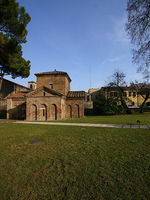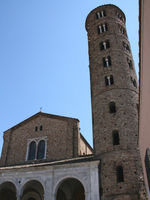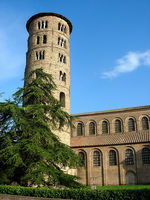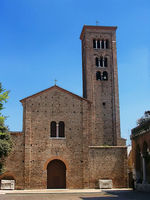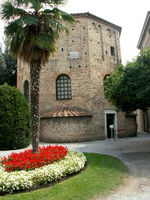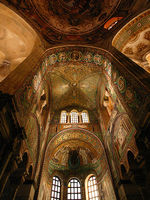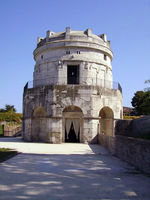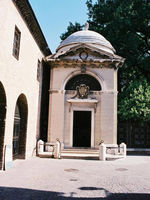Mausoleum of Galla Placidia
Galla Placidia (386-452), the sister of Honorius, the Roman Emperor who moved the Capital of the western empire from Milan to Ravenna, built this little Latin cross plan Mausoleum around 425-450. It is famous today for the splendour of its mosaics. The exterior is very sober, contrasting with the magnificence of the interior decoration, the most ancient in Ravenna. Mosaics cover the walls of the vault, the lunettes and the cupola. The iconographic themes developed in the decorations represent the victory of life over death, in accordance with the funereal character of the building.
The mausoleum by nightThe spell of the starry sky of Galla Placidia
The atmosphere of the Mausoleum of Gall Placidia is undoubtedly magical. On entering the small building, constructed in the form of a Latin cross, the visitor is struck by the sudden change from daylight to a created nocturnal ambience. The countless stars of the cupola have made a profound impression on the imagination and sensitivity of visitors to Ravenna. It is said that Cole Porter, while on his honeymoon in our city at the end of the 1920s, was so impressed by the mood of the small mausoleum that he wrote his famous Night and Day while thinking of the starry sky of Galla Placidia.
Via Benedetto Fiandrini
Ph. 0544-541688
Times
9.00-17.30 (ticket office closes at 5.15 pm)
Basilica of Sant'Apollinare Nuovo
The BasilicaThe Basilica of Sant'Apollinare Nuovo was built in the 6th century originally as Theodoric's palatinate church. Perhaps the façade was originally closed by a four sided portico, but now it is preceded by a simple but harmonious 16th century marble portico. On the right side there is a cylindrical bell-tower of the 9th or 10th century, characteristic of the buildings of Ravenna. From the ancient building we have the magnificent mosaics with the largest surface area which has come down to us from antiquity. The processions of Virgins and Martyrs represent one of the most typical examples of the Byzantine style.
Via di Roma
Ph. 0544-541688
Times
9.30-17.30 (ticket office closes at 5.15 pm)
Basilica of Sant'Apollinare in Classe
It was built by Giuliano Argentario on behalf of Archbishop Ursicinus during the first half of 6th century. It is one of the most perfect Basilicas in Ravenna. Besides its architectonic structure, it is well-known for its mosaics and marble sarcophagi of former archbishops along the side naves.
Via Romea Sud
Ph. 0544-473569
working days times: 8.30 am-07.30 pm (ticket office closes at 07.00 pm)
holy days times: 01.30 pm -07.30 pm (ticket office closes at 07.00 pm)
sundays till 01.00 pm church service
Basilica of San Francesco
The original 5th century church was dedicated to the Apostles, but nothing remains of the ancient construction which was completely rebuilt in the 10th and 11th century; in the same period the imposing square bell-tower was added. The church is characterised by very simple lines; the brick façade has a small mullioned window in the middle. Beneath the high altar, 5th century sarcophagus, clearly visible through a window, the 10th century crypt is of the "oratory" type supported by columns. On the floors, always full of water, there are fragments of mosaics of the original church of Neone: a rather unusual sight. In 1321 the funeral of Dante Alighieri, who was buried near the church, was certainly held here.
Contacts
Piazza San Francesco
Ph. 0544-33256
Times
7.30 am-12.00 am 02.30 pm- 06.30 pm
Neonian Baptistry
The most ancient of Ravenna monuments, at least with regard to when building began, it dates to the end of the 4th or the beginning of the 5th century. It is a simple octagonal plan brick building with four large niches spreading towards the exterior and with the doors buried (the original level is about three metres below the present one). The Baptistery was splendidly decorated with mosaics by bishop Neone in 450. Inside, besides very beautiful mosaic decoration of Hellenic-Roman influence, several stucco-works and marble parts remain. In the middle there is an octagonal font of Greek marble and porphyry, reworked in the 16th century, which still preserves some original fragments.
Piazza Duomo
Ph. 0544-541688
9.30 am -05.30 pm (ticket office closes at 05.30 pm)
Basilica of San Vitale
Basilica of S. VitaleOctagonal plan church, founded by Giulianus Argentarius, commissioned by Bishop Ecclesius and consecrated by the Archbishop Maximian in 548. The Basilica of San Vitale is among the most important monuments of early Christian art in Italy, above all for the splendour of its mosaics. The eastern influence, always presents in the architecture of Ravenna, has a dominant role here. No longer a basilica with nave and two aisles but a central octagonal plan, surmounted by a cupola and the whole supported on 8 pilasters and arches. The dome ceiling and the niches were decorated by frescoes painted in 1780 by Barozzi and Gandolfi of Bologna and Guarana of the Veneto. It should be Notesd that the floor is kept dry by pumps since it is below the level of the water table.
Via Benedetto Fiandrini
Ph. 0544-541688
9.00 am -05.30 pm (ticket office closes at 05.15 pm)
from 10th of july to 11th of settember, from tuesday to thursdays 09.00 pm -11.00 pm
Mausoleum of Theodoric
It was built by Theodoric himself in 520 as his tomb. Its structure, which is divided in two decagonal orders one above the other, is completely made of Istria stone. It is roofed with a single block of Istria stone of 10 metres diameter weighing 300 tons. A niche leads down to a room which was probably a chapel for funeral liturgies. A stair leads to the upper floor where there is a circular porphyry tub in which it is supposed that Theodoric was buried. His remains were removed during Byzantine rule.
Via delle Industrie
Ph. 0544-684020
8.30 am -04.00 pm (ticket office closes at 03.30 pm)
Tomba di Dante
The little temple, built in 1780 by the architect Camillo Morigia, contains the sarcophagus with the bones of Dante. The exterior is in Neo-classical style, and inside, above the sarcophagus, there is a 1483 relief by Pietro Lombardo depicting Dante at a reading desk. In the middle of the temple there is an 18th century lamp kept burning with oil from Tuscan olive trees which is donated annually by the municipality of Florence on the second Sunday of September. On the right a gate leads into the garden of the so-named Quadrarco di Braccioforte, beneath which there are two sarcophagi.
Via Dante Alighieri
Ph. 0544-33662
Times 10.00 am -06.30 pm





